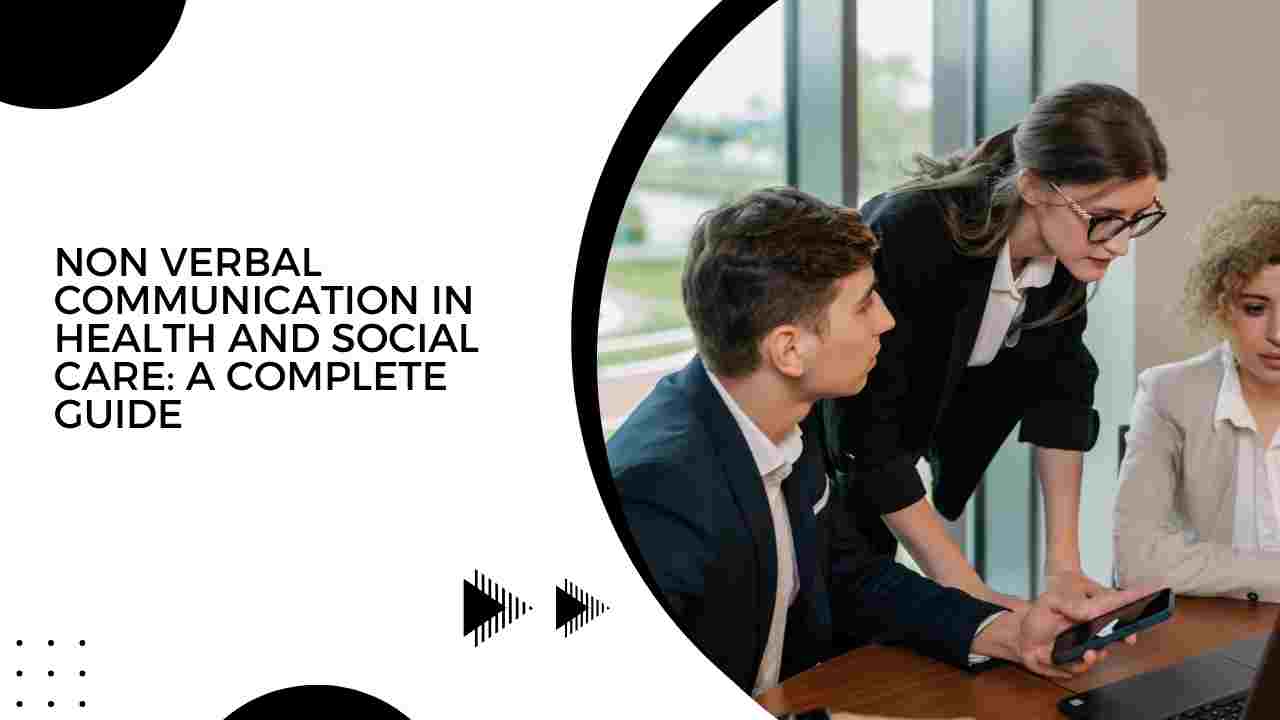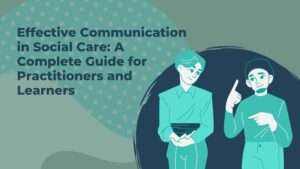Introduction
It need more than just words to communicate in the health and social care sectors. Nonverbal cues including body language, posture, tone, eye contact, facial expressions, gestures, and even silence play a significant role in human interactions. In care environments, non verbal communication in health and social care can express empathy, understanding, and respect—often more powerfully than words.
This comprehensive handbook aims to improve service delivery and foster person-centered interactions by assisting students, practitioners, and care managers in comprehending, mastering, and utilizing nonverbal communication.
What is Non Verbal Communication in Health and Social Care?
The term “nonverbal communication” describes all of the ways in which people express meaning without speaking. This encompasses the following in health and social care:
- Facial expressions
- Eye contact
- Gestures
- Touch
- Proximity (personal space)
- Posture
- Tone of voice (paralinguistics)
- Appearance and clothing
- Silence and pauses
Non verbal signals can support or contradict what is being said, and are often interpreted intuitively by service users.
Why Non Verbal Communication Matters in Care
- Builds rapport and trust with service users
- Supports those with communication impairments (e.g. dementia, autism, stroke recovery)
- Conveys compassion and empathy during emotional or distressing moments
- Enhances clarity when words are limited or confusing
- Reduces misunderstandings across cultural or linguistic barriers
Key Types of Non Verbal Communication in Care Settings
1. Facial Expressions
Smiling, frowning, or a look of concern communicates emotions instantly.
2. Eye Contact
Signals attentiveness and engagement. Avoiding eye contact may imply disinterest or discomfort.
3. Body Posture
An open posture shows interest and respect. Crossed arms or slouching can seem dismissive.
4. Gestures
Nods, waves, or hand movements can reinforce verbal messages or offer reassurance.
5. Touch
A gentle hand on the shoulder or holding a hand may provide comfort—when appropriate and consented.
6. Paralinguistics
Tone, pitch, volume, and rhythm all affect how speech is interpreted.
7. Silence
A powerful tool to give space for emotions or reflection, or to show respect.
Cultural Considerations in Non Verbal Communication
Different cultures interpret non verbal cues differently:
- Eye contact may be seen as respectful in some cultures and rude in others.
- Physical touch may be comforting or intrusive, depending on cultural norms.
- Personal space boundaries vary widely.
Best practice: Ask individuals about their preferences and be culturally sensitive.
Non Verbal Communication and Specific Care Groups
1. Elderly People
- Use calm body language and slow movements.
- Maintain eye contact, smile warmly.
2. People with Autism
- Avoid overly expressive gestures or close proximity.
- Respect sensory sensitivities.
3. Children and Young People
- Get on their level physically.
- Use animated facial expressions and gestures.
4. People with Dementia
- Speak slowly with calm tone.
- Use touch and facial expressions for reassurance.
5. Deaf or Hearing Impaired Individuals
- Emphasise lip-reading, facial expressions, and gestures.
- Use sign language if appropriate.
Non Verbal Communication in Multidisciplinary Teams
- Maintain professional posture and appearance.
- Use consistent eye contact and nodding to show agreement.
- Respect personal space and boundaries in meetings or ward rounds.
Enhancing Non Verbal Skills in Practice
- Reflect on your own body language in daily care routines.
- Ask for feedback from colleagues and supervisors.
- Observe service users’ reactions to your presence and expressions.
- Use video training or mirror practice to improve facial and posture awareness.
Common Barriers and Misinterpretations
| Barrier | Impact | Strategy |
| Cultural misalignment | Offense or confusion | Ask about preferences, avoid assumptions |
| Physical disability | Reduced control over expressions or gestures | Focus on eye contact and tone |
| Mental health conditions | Anxiety, paranoia may affect interpretation | Use calm, consistent body language |
| Staff fatigue | Slumped posture, flat tone | Take breaks, practice mindfulness |
| Personal bias | Unconscious expressions of judgment | Stay self-aware, reflective practice |
Scenarios: Applying Non Verbal Communication
Scenario 1: Palliative Care Support
A nurse sits next to a patient who is near death, holding their hand tenderly, making eye contact, and smiling warmly without saying anything. Words cannot express how reassuring the relationship is.
Scenario 2: Calming a Distressed Child
A support worker kneels to the child’s eye level, keeps a soft tone, nods calmly, and gives space until the child is ready to talk.
Scenario 3: Professional Team Meeting
A senior care worker maintains eye contact, nods while others speak, and uses open hand gestures to indicate inclusivity.
Legal and Ethical Considerations
- Consent for touch: Always seek verbal or non verbal permission before physical contact.
- Dignity and respect: Avoid invasive gestures or expressions that may embarrass.
- Confidentiality: Use discreet body language and settings for private discussions.
- Equality Act 2010: Provide reasonable adjustments for communication support.
Training and Development Resources
- CPD courses on non verbal communication
- Dementia communication workshops
- Autism-friendly communication training
- Reflective practice sessions
- Role play and simulation activities
Non Verbal Communication and Person-Centred Care
- Observe individual preferences: some may prefer more or less physical proximity.
- Match your emotional expression to the individual’s mood.
- Use consistent non verbal signals to build trust.
- Allow non-verbal cues from service users to guide your response.
Conclusion
Non verbal communication in health and social care is an invisible language that speaks volumes. It improves connections, promotes wellbeing, and guarantees that care is genuinely person-centered when applied with awareness, empathy, and respect. Carers can establish a stronger connection and provide exceptional assistance without constantly speaking by learning to read our facial expressions, body language, and silence.
Develop a daily habit of nonverbal awareness to improve your practice. Think, adapt, watch, and most importantly, be in the moment.
Read more:







